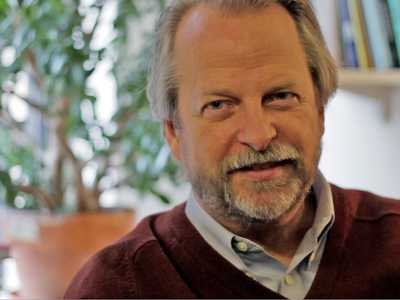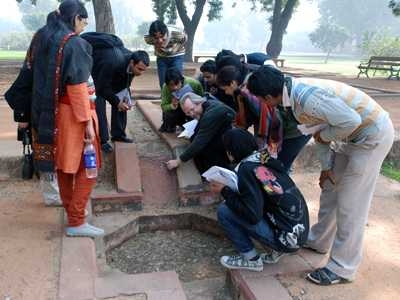It is a long way from the gardens of India’s Taj Mahal to the Colorado River, which tumbles out of the Rocky Mountains and runs through the southwestern United States, sustaining tens of millions of Americans. But the two places are closely linked in the work of James Wescoat, MIT’s Aga Khan Professor of Architecture.
Wescoat, 58, is a landscape architect and geographer who specializes in the study of water, using a decidedly interdisciplinary approach. An expert on the grand Mughal gardens built in the 16th and 17th centuries in what is now India and Pakistan, Wescoat applies his insights from South Asia’s distant past to the use of water in contemporary America as well as Asia.
“Water has been the unifying theme in my work,” said Wescoat. “Especially the study of water-conserving design across different scales, regions and cultures.”
This theme has fully emerged after decades of fieldwork by Wescoat in Asia and America, dating to the 1970s. Mughal architecture features a distinctive fusion of Indian and Islamic building styles used in forts, mosques and tombs. The best known example of this style of architecture is the Taj Mahal, completed around 1650. These structures are often surrounded by grand gardens with large, decorative pools of water. Years ago, Wescoat broke scholarly ground by recognizing that the pools constituted notable feats of civil engineering and political action, since water was often in short supply where they were built. Channeling water into the gardens required technological innovations, refined over time.
From this observation about South Asia, Wescoat has consistently emphasized that landscape architects everywhere should think about structures in geographic and environmental terms, to see how societies draw on local water supplies. He has written or edited 10 books and dozens of articles about the relationship between resources and society in South Asia and America.
“Water is to landscape what energy is to buildings,” said Wescoat, who joined the MIT faculty in 2008. Both water and energy are valuable resources powering the inhabited world. Only by closely scrutinizing how water is distributed throughout society, he said, can we understand if our environmental plans are sustainable.
This approach has earned Wescoat a diverse audience of scholars. “Jim’s work is read by art historians, geographers, planners, landscape architects, environmental scientists, and is important to them all,” said Dede Ruggles, a professor of landscape architecture at the University of Illinois. “He stretches across a broad swath of academia and talks easily to all these groups.”
Water, water, everywhere
Wescoat’s work is especially timely now, with water supply issues becoming critical in many regions. In September, Lake Mead, a key reservoir on the Colorado River, came within inches of its lowest point, set in 1956 — when population demands on the water system were far lower. The current situation “is staggering,” said Wescoat, who started studying the Colorado River use in the 1970s, and published his first monograph on the topic in 1984.
Indeed, Wescoat’s work “brought geography into design and planning a whole decade ahead of everybody else, particularly in the area of water, which has become a hot topic in research today,” said Hashim Sarkis, a professor of urban planning and design at Harvard.
Wescoat, who specializes in the study of water, discusses his use of a decidedly interdisciplinary approach in his research.
Video: Melanie Gonick; still images: James Wescoat/Aga Khan for Culture, India/Aga Khan Planning and Building Service, Pakistan
At the moment, Wescoat is researching how small-scale conservation tools can be applied to towns, cities and larger urban agglomerations. “We’re really focused on taking water-conserving technologies and then scaling up,” he said. “One of the great questions is how microscale solutions, such as new technologies in irrigation science, can provide urban and regional benefits.”
Increasingly, Wescoat noted, irrigators do not just give their crops customary amounts of water, but instead use local weather stations and soil-moisture sensors to know how much moisture the land is holding, and how much it will likely need in real time. That saves water over time. “Agronomic science can be brought into the city,” Wescoat said. “A campus like MIT could have controllers measuring microclimatic conditions and making sure plants get what they need — no more, no less.” Smart technologies can also better regulate water use in buildings, from the rooftops to water reuse, as seen in the bioswale behind MIT’s Stata Center.
Such advances are badly needed, Wescoat said. It is not just the American West that has a supply shortage; Atlanta, he noted, nearly ran out of water recently. But progress is always possible, he insisted. “Asking people to change their behavior and reduce water use has actually been successful,” said Wescoat. In Phoenix and Las Vegas, two cities that use the Colorado River’s supplies, per-capita water use has dropped 20 and 21 percent, respectively, since 2000.
As dire as water-shortage warnings sound, Wescoat said he considers himself an optimist when it comes to society’s ability to change. Some of that stems from his studies of South Asian history, where people with different cultural and technological approaches have often learned how to use water expertly. Moreover, as Wescoat observed in his 2003 book, Water for Life, civilizations have been water engineers for thousands of years, showing that we have both a history of ingenuity in the field and a track record of improvements.
“When you’re able to reflect on earlier achievements and transformations, and see how people adapted, it really helps to inspire people to work in new ways,” said Wescoat. “The kind of work I do is problem-driven, but solution-oriented. It’s about trying to find the paths for hope.”
Wescoat, 58, is a landscape architect and geographer who specializes in the study of water, using a decidedly interdisciplinary approach. An expert on the grand Mughal gardens built in the 16th and 17th centuries in what is now India and Pakistan, Wescoat applies his insights from South Asia’s distant past to the use of water in contemporary America as well as Asia.
“Water has been the unifying theme in my work,” said Wescoat. “Especially the study of water-conserving design across different scales, regions and cultures.”
This theme has fully emerged after decades of fieldwork by Wescoat in Asia and America, dating to the 1970s. Mughal architecture features a distinctive fusion of Indian and Islamic building styles used in forts, mosques and tombs. The best known example of this style of architecture is the Taj Mahal, completed around 1650. These structures are often surrounded by grand gardens with large, decorative pools of water. Years ago, Wescoat broke scholarly ground by recognizing that the pools constituted notable feats of civil engineering and political action, since water was often in short supply where they were built. Channeling water into the gardens required technological innovations, refined over time.
From this observation about South Asia, Wescoat has consistently emphasized that landscape architects everywhere should think about structures in geographic and environmental terms, to see how societies draw on local water supplies. He has written or edited 10 books and dozens of articles about the relationship between resources and society in South Asia and America.
“Water is to landscape what energy is to buildings,” said Wescoat, who joined the MIT faculty in 2008. Both water and energy are valuable resources powering the inhabited world. Only by closely scrutinizing how water is distributed throughout society, he said, can we understand if our environmental plans are sustainable.
This approach has earned Wescoat a diverse audience of scholars. “Jim’s work is read by art historians, geographers, planners, landscape architects, environmental scientists, and is important to them all,” said Dede Ruggles, a professor of landscape architecture at the University of Illinois. “He stretches across a broad swath of academia and talks easily to all these groups.”
Water, water, everywhere
Wescoat’s work is especially timely now, with water supply issues becoming critical in many regions. In September, Lake Mead, a key reservoir on the Colorado River, came within inches of its lowest point, set in 1956 — when population demands on the water system were far lower. The current situation “is staggering,” said Wescoat, who started studying the Colorado River use in the 1970s, and published his first monograph on the topic in 1984.
Indeed, Wescoat’s work “brought geography into design and planning a whole decade ahead of everybody else, particularly in the area of water, which has become a hot topic in research today,” said Hashim Sarkis, a professor of urban planning and design at Harvard.
Wescoat, who specializes in the study of water, discusses his use of a decidedly interdisciplinary approach in his research.
Video: Melanie Gonick; still images: James Wescoat/Aga Khan for Culture, India/Aga Khan Planning and Building Service, Pakistan
At the moment, Wescoat is researching how small-scale conservation tools can be applied to towns, cities and larger urban agglomerations. “We’re really focused on taking water-conserving technologies and then scaling up,” he said. “One of the great questions is how microscale solutions, such as new technologies in irrigation science, can provide urban and regional benefits.”
Increasingly, Wescoat noted, irrigators do not just give their crops customary amounts of water, but instead use local weather stations and soil-moisture sensors to know how much moisture the land is holding, and how much it will likely need in real time. That saves water over time. “Agronomic science can be brought into the city,” Wescoat said. “A campus like MIT could have controllers measuring microclimatic conditions and making sure plants get what they need — no more, no less.” Smart technologies can also better regulate water use in buildings, from the rooftops to water reuse, as seen in the bioswale behind MIT’s Stata Center.
Such advances are badly needed, Wescoat said. It is not just the American West that has a supply shortage; Atlanta, he noted, nearly ran out of water recently. But progress is always possible, he insisted. “Asking people to change their behavior and reduce water use has actually been successful,” said Wescoat. In Phoenix and Las Vegas, two cities that use the Colorado River’s supplies, per-capita water use has dropped 20 and 21 percent, respectively, since 2000.
As dire as water-shortage warnings sound, Wescoat said he considers himself an optimist when it comes to society’s ability to change. Some of that stems from his studies of South Asian history, where people with different cultural and technological approaches have often learned how to use water expertly. Moreover, as Wescoat observed in his 2003 book, Water for Life, civilizations have been water engineers for thousands of years, showing that we have both a history of ingenuity in the field and a track record of improvements.
“When you’re able to reflect on earlier achievements and transformations, and see how people adapted, it really helps to inspire people to work in new ways,” said Wescoat. “The kind of work I do is problem-driven, but solution-oriented. It’s about trying to find the paths for hope.”







